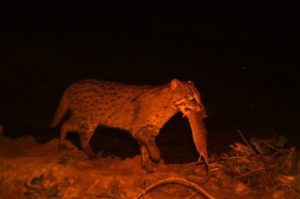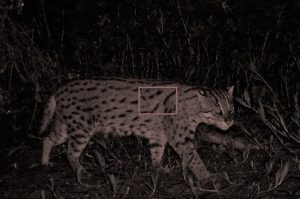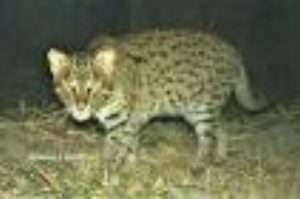Fishing Cat Makes Rare Debut – West Bengal has once again proved why it is known as one of India’s richest biodiversity hubs. In a development hailed by wildlife lovers and conservationists, the elusive Fishing Cat (Prionailurus viverrinus), the state animal of West Bengal, has been officially recorded for the first time in parts of western Bengal, marking a milestone in wildlife documentation and conservation efforts.

This rare sighting is not just a matter of ecological pride but also a reminder of the importance of wetlands and habitats that sustain this semi-aquatic feline species. For decades, the fishing cat had largely been restricted to the marshes, wetlands, and mangroves of eastern India, particularly the Sunderbans, Howrah, and North 24 Parganas districts. The confirmation of its presence in the western districts, however, widens the known range of the species in the state, offering hope for its long-term survival amid rising threats.
A Historic Moment for Bengal’s Wildlife
Wildlife researchers and forest officials confirmed that motion-sensitive camera traps and physical signs of movement recorded in western districts of Bengal indicated the presence of fishing cats. The confirmation is seen as “historic” because it expands Bengal’s ecological map, proving that even in regions beyond the Sunderbans and riverine wetlands, this species continues to find new habitats.
“This is a proud moment for Bengal’s conservation journey. The fishing cat’s presence in western Bengal is a testament to the resilience of our ecosystems, but also a wake-up call to protect the remaining wetlands and marshes that are under constant pressure,” said a senior official from the state forest department.
Why the Fishing Cat Matters
The fishing cat is not just another wild cat—it is a keystone species and an indicator of wetland health. Found in South and Southeast Asia, it is classified as Vulnerable on the International Union for Conservation of Nature (IUCN) Red List due to habitat loss, poaching, and wetland degradation.


Known for its partially webbed feet, strong body, and swimming ability, the fishing cat thrives in marshes, mangroves, riversides, and floodplains. Its diet largely consists of fish, frogs, and other aquatic animals. In Bengal, it also holds cultural and symbolic importance, being declared the State Animal of West Bengal in 2012.
Fishing Cat Makes Rare Debut: Conservation Challenges
While this sighting in western Bengal is encouraging, conservationists warn that the species still faces severe threats. Rapid urbanization, unplanned real estate development, plastic pollution, and the filling up of wetlands for housing projects continue to destroy its habitat.
A study by the Wetlands International South Asia revealed that India has been losing wetlands at an alarming rate of nearly 2–3% per year, with West Bengal among the worst-affected states. Experts believe that unless strict protection and community-based conservation are implemented, the fishing cat could disappear from several regions.
Voices from the Ground
Local villagers in the newly identified western Bengal zone reported occasional sightings of “large cats near ponds and water bodies.” Initially, these were dismissed as jungle cats, but researchers now believe they were fishing cats.
Environmental activist Ruma Mukherjee, who has been campaigning for wetland conservation in Bengal, described the find as “a sign of hope.” She said, “The fishing cat’s presence is a reminder that our wetlands are alive. But these wetlands are under siege from landfills and pollution. Protecting this species means protecting our own future, because wetlands also guard us from floods, droughts, and climate disasters.”
Government and Policy Response
The West Bengal government has already initiated plans to conduct a statewide survey of fishing cat habitats. The forest department, along with NGOs such as The Fishing Cat Project and WWF India, are collaborating to map out wetland patches and design community-based conservation programs.
The introduction of eco-tourism opportunities around these habitats is also being considered, with the dual aim of generating income for local communities and ensuring protection of the species.


Community Role in Conservation
Experts argue that conservation cannot succeed without community participation. Local fishermen and villagers living near wetlands are often the first to spot fishing cats. In some cases, however, the animal is killed due to mistaken identity or fear that it may attack poultry. Awareness programs are being planned to educate communities about the ecological role of fishing cats.
One proposed model is the “Fishing Cat Guardians” initiative, which incentivizes villagers to report sightings and protect wetland areas. NGOs also aim to integrate women’s self-help groups into wetland management, as women in rural Bengal are traditionally involved in fishing and water-related activities.
Bengal’s Wetlands: A Precious Heritage
The fishing cat’s expansion into western Bengal adds urgency to the conversation around wetland preservation. Wetlands like East Kolkata Wetlands (a UNESCO Ramsar site), the Sunderbans, and several riverine stretches in the state are not just wildlife habitats but also provide livelihood for thousands of people.
The Ramsar Convention on Wetlands highlights the role of wetlands in climate regulation, water purification, and food security. West Bengal, being highly vulnerable to climate change and rising sea levels, stands to lose immensely if its wetlands are neglected.
Learn more about Ramsar sites in India.
Looking Ahead: A Balance Between Development and Ecology
Experts warn that balancing Bengal’s rapid urban expansion with ecological protection is now the biggest challenge. Development projects, highways, and real estate expansion often encroach upon wetland habitats. Without strict enforcement of environmental laws, the fishing cat’s survival in newly found western Bengal areas will remain uncertain.
Dr. Subhajit Ghosh, a wildlife biologist, emphasized: “This sighting is not just good news—it is a responsibility. Bengal now has proof that the species’ range is wider than we thought. But will we allow it to thrive? That depends on how seriously we take wetland conservation from today.”
Conclusion
The rare debut of the fishing cat in western Bengal is a moment of pride, hope, and responsibility. It proves that Bengal’s ecological heritage continues to surprise us with resilience, but it also underlines the urgent need to preserve wetlands before it is too late.
As the state animal of West Bengal, the fishing cat is more than just a symbol—it is a guardian of wetlands, a fighter for biodiversity, and a reminder that nature rewards us when we care.
With collective action from the government, conservationists, and communities, this historic sighting could mark the beginning of a stronger conservation era in Bengal. If ignored, however, it may remain only a fleeting chapter in the story of a species fighting for survival.
✅ Authentic External References for Context:
- IUCN Red List – Fishing Cat
- WWF India – Fishing Cat Conservation
- Wetlands International South Asia
- Ramsar Convention on Wetlands
Also read: Home | Channel 6 Network – Latest News, Breaking Updates: Politics, Business, Tech & More

